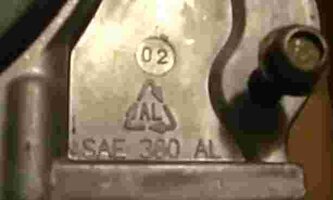That theory comes under much suspicion when you consider that since the Transfer Case Gerotor Fluid Pump is directly connected to the Large Drive Chain and thus,
permanently powered by it... its Outer Pump Housing Flange persistently manages to pound out three distinct holes, right through the Magnesium Outer Housing over time.
This phenomena would never happen if the ONLY time that the TC Gerotor Fluid Pump was theoretically "at work" by getting engaged in Neutral and then only be applied during Towing. Ask yourself... Which is the more likely cause of such a condition to damage the case?
(1) Whenever the Transmission is deliberately being shifted into Neutral...and therefore under NO LOAD.... the Gerotor Oil Pump engages to lubricate.
or...
.
(2) The NV design of Transfer Case Gerotor Fluid Pump is NOT adjudicated by means of any special clutch feature and thus, it is always in constant motion and Pumping Fluid whether the Engine & Transmission Torque is being applied Full On during Hard Acceleration or to a lesser extent as soon as the Gas Pedal is let Off. The damage phenomena occurs to the case because of these innumerable events because the Load is either being Added or Relaxed whenever the Accelerator Pedal is either Applied or Let Off...but the Pump prevails pumping fluid, regardless of the Volume of the Fluid being moved..
The Two most prevalent causes of Catastrophic GM Transfer Case Failure BOTH involve the Failure of the Gerotor Fluid Pump:
(A) A Total Drainage or Loss of Transfer Case Fluid due to the Three Hole Damage to the Outer Magnesium Housing after being impacted by the Gerotor Fluid Pump Outer Plate.
(B) A Catastrophic Destruction of the Transfer Case Gerotor Fluid Pump where either the two halves are ruined with the base rotation around and tearing out the TC Fluid Pick Up Tube resulting in a Complete Loss of Gerotor Pump Fluid Pressure.
This is a supporting article (with photos) from, "Bob' IS The Oil Guy" showing the actual points on the case that become damaged for the nearly constant pounding from the Transfer Case Gerotor Fluid Pump:
Hopefully this will help someone avoid an expensive repair in the future. This problem affects the 1500, 2500, and 3500 series trucks but I'm not 100% certain which year models. In November I noticed my truck started to "thump" when I let off the brakes after coming to a stop and sometimes as...
bobistheoilguy.com
One last observation. All Gerotor Oil (Fluid) Pumps are made such that they will only function when a constant supply of oil is present. This is due to the requisite establishment of a Post-Prime Vacuum in order to draw fluid into the Dual Rotors of the Gerotor Oil Pump and allow the fluid to be constantly moved along either at a Greater or Lesser Volume.
If you require more evidence of this... please visit the images of my Gerotor Oil Pump Autopsy to see these requirements in more detail:
This Album shows Images of the Autopsy of a Late Model GM 4.2L LL8 Gerotor Oil Pump.

www.flickr.com
The NV Transfer Case Gerotor Oil Pump follows this identical design and like the "Blue" Viton "O" Ring is necessary to maintain a permanent suction from the Oil Pick Up Tube Screen in the base of the 4.2L Engine, likewise the TC Gerotor Fluid Pump uses a Special "O" Ring Seal around the Tube leading down to the Screened Rectangular Oil Pick Up Tube where it is buried in the bottom of the Case where hopefully, the Blue ACDelco TC Fluid resides in sufficient quantity and must do so in order to maintain a Solid Fluid Column from bottom to top. Breaking this up action with any intermediate mechanism might risk Catastrophic Air Cavitation if the TC Fluid Pump were to Lose its Fluid Prime.
In the case of the GM 4.2L Motor... from the moment the engine turns over, the Mechanical Gerotor Oil Pump instantly applies Oil Pressure. So too does the Gerotor Fluid Pump inside the NV Transfer Case whenever the Main Drive Chain is in motion. Neither one can afford NOT to be working at all times when anything is moving down there and any mechanical parts are in motion, regardless of whether the Engine Torque Loads are increased or decreased.
Please supply any additional source information that might improve our understanding.
Note: Casing manufacture nomenclature distinctions are:
NV = "New Venture"
NP = "New Process"







